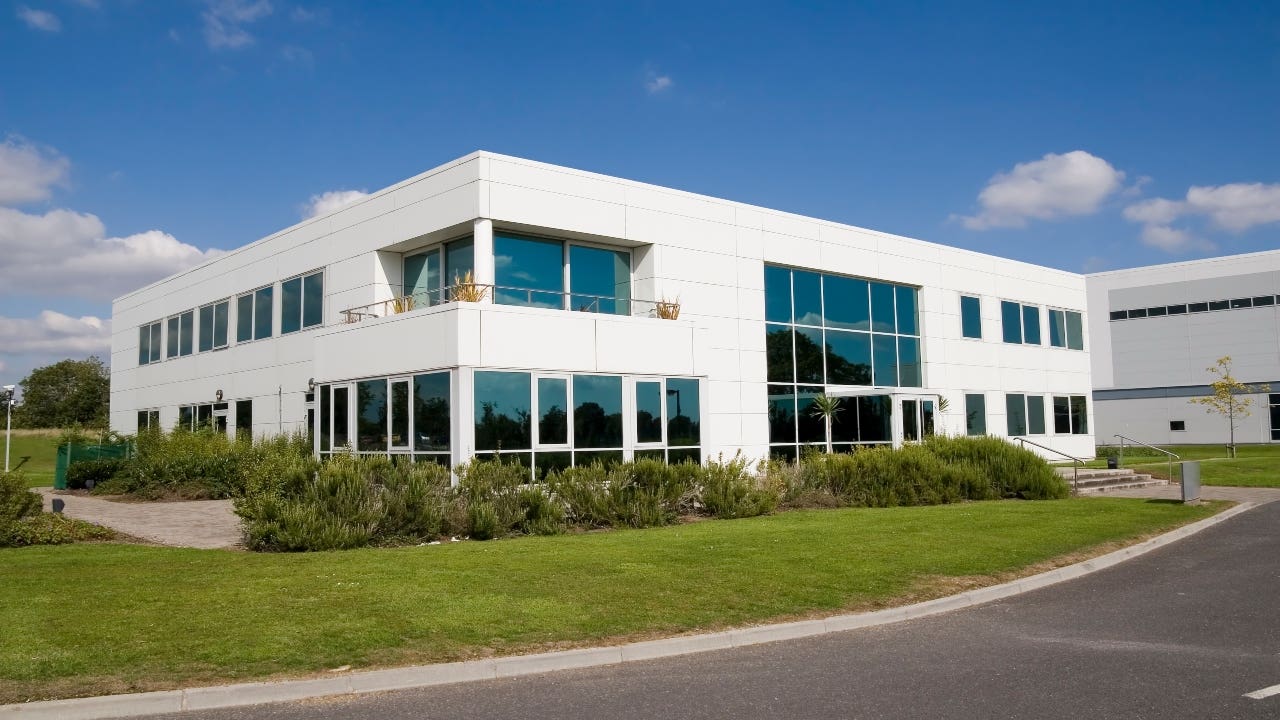What are commercial real estate or CRE loans?

The Bankrate promise
At Bankrate we strive to help you make smarter financial decisions. While we adhere to strict , this post may contain references to products from our partners. Here's an explanation for .
Key takeaways
- Commercial real estate loans are used to purchase, construct, rehabilitate or refinance commercial properties, as opposed to residential ones.
- However, they might also be used to buy and develop land for residential homes to be built and sold.
- With a CRE loan, the borrower's credit and income are less important than in residential loans — the property's potential income is the main factor.
Whether you’re a developer embarking on a new subdivision project or an office building owner looking to refinance, chances are you’ll need a commercial real estate loan. Unlike residential real estate, commercial real estate refers to property that’s used for business, such as a hotel, office park or shopping center. The typical commercial real estate loan borrower might be a business owner (including small business owners), developer or investor. Commercial real estate loans work differently than residential mortgages in terms of underwriting, structure, interest rates and fees, and there are several types to choose from.
What are CRE loans?
Commercial real estate loans, often called CRE loans for short, are typically used to purchase, construct, rehabilitate or refinance commercial, industrial and other non-owner-occupied property. That can include office buildings, multi-unit rental buildings, medical facilities, warehouses, hotels or vacant land on which one or more of these types of properties will be built. They can also be used to buy and develop land on which homes will be constructed and sold.
Unlike buying a home with a residential mortgage, the underlying asset for a commercial loan is not a primary residence. Instead, the commercial lender underwrites based on the income — such as rent from tenants — and expenses that the property will generate.
“Ideal candidates to pursue a commercial real estate loan include borrowers who either own the property and are seeking to lower their interest rate by refinancing or seek to obtain capital through a cash-out refinance,” says Chris Moreno, CEO of GoKapital in Miami. “Business owners who rent a location and qualify for a commercial real estate loan may be better off obtaining financing to purchase their business property.”
Commercial real estate loan types
CRE loans come in many different varieties. Here’s a rundown of common commercial real estate loan types to pick from.
| Loan type | What to know |
|---|---|
| Conventional commercial real estate loan | Offered by banks, credit unions and other lenders, with terms ranging from five to 30 years, interest rates as low as 3 percent and a minimum down payment of up to 20 percent. |
| Commercial bridge loan | Offered by various banks and lenders as a means to bridge the financing gap until longer-term financing is found. Terms usually span six months to three years, with only a 10 to 20 percent down payment often required. |
| SBA 7(a) loan | Provided by lenders who partner with the Small Business Administration (SBA). Financing arrangements offer borrowers up to $5 million over a maximum term of 25 years, with 10 to 20 percent down payment often required. |
| SBA 504 loan | Consists of a Certified Development Company (CDC) loan portion (for up to 40 percent of the total borrowed amount) plus a bank loan (for up to 50 percent of the total borrowed amount). The collective maximum balance is $5.5 million, terms range from 10 to 25 years and down payment requirements can be as low as 10 percent. |
| CMBS or conduit loan | Part of a pool of commercial real estate loans (a commercial mortgage-backed security, or CMBS) sold on the secondary market by conduit lenders and investment banks. Terms usually span five to 10 years with an amortization of 30 years; 25 to 30 percent down is often needed. |
| Hard money loan | Works like a bridge loan, but is typically offered by a private lender. |
| USDA CRE loan | Designed to support the development and improvement of commercial properties in rural areas and offered by approved lenders in partnership with the USDA. Terms can vary up to 30 years, often with a minimum down payment of 10 percent. |
Commercial real estate loans are also classified by asset classes. These include apartment buildings, office spaces, medical facilities and industrial properties, as well as multi-unit versus single-tenant assets.
“All of these are evaluated differently by the lender,” says Barry Saywitz, president of the Saywitz Company, a commercial real estate brokerage based in Newport Beach, California. “The value of the asset will be determined by the appraisal required, and the appraisal will be determined based on the quality of the tenant, their credit, payment history and rental rate, and the condition of the building and expenses involved.”
CRE loans for investment properties
Commercial real estate loans can be ideal for financing many different kinds of investment properties. But it’s important to understand the rules.
“The investment property must be capable of generating income, and the strength of the sponsor/owner will likely be relied upon for evaluating the loan,” says Rohit Mathur, CEO of commercial lending company Bridge in New York City and Charlotte.
Like all loans, the lender will broadly evaluate the confidence that the loan for an investment property will be repaid, according to Adam Kenney, chief product officer for Numerated, a Boston-based commercial lending platform.
“What’s unique about a CRE loan is that the property will get evaluated as much or potentially more than the business holding the loan,” Kenney says. “The property’s ability to reliably produce positive cash flow is almost always going to be the biggest determining factor in the ability to repay the loan.”
Commercial loan rates fluctuate depending on the property type and the anticipated income it will generate. Commercial buyers may need to provide a larger down payment than regular homebuyers, as commercial lenders typically require lower loan-to-value ratios. Just like with residential loans, commercial loan interest rates are influenced by various factors and adjust frequently based on market conditions.
Commercial loan vs. residential loan
Commercial loan
- Used for development and business properties
- Underwriting relies on the business financial plan
- Typically shorter payoff periods
Residential loan
- Used for personal residences
- Underwriting relies on the personal finances of the borrower
- Typically longer payoff periods
Like a residential mortgage, a commercial mortgage can be used to purchase or refinance a property. Commercial real estate loans, however, typically come with a shorter term than a residential mortgage loan. A commercial loan could have fixed rate for five years and a 15-year term, amortized over 20 years, for example, says James Sandagato, senior vice president at Cornerstone Bank in Southbridge, Massachusetts.
“The interest rate would adjust every five years, and the balance would be due at the end of the 15-year term, which is referred to as a balloon note,” Sandagato says. “The balance could then be repaid at the end of the term, or the loan can be renewed on rates, terms and conditions to be determined at that time.”
Commercial loan lenders also look to the property, not the borrower, as the source of debt repayment. “With a residential loan, the lender underwrites the repayment capacity of the borrower by analyzing his or her income and creditworthiness,” says Suzanne Hollander, a real estate attorney and professor at Florida International University in Miami. “A commercial loan lender looks at the debt service coverage ratio from the income the property will generate.”
Riley Manke, a director at Walker & Dunlop in Calabasas, California, notes that residential loans “rely heavily on a borrower’s credit score and their debt-to-income ratio, while CRE underwriting relies on a borrower’s net worth, liquidity and experience with the product type they are seeking financing on.”
In addition, the fees and closing costs involved with a commercial real estate loan are commonly much higher than those for a residential mortgage, along with the down payment. Count on making a down payment of at least 20 percent, although up to 45 percent could be required.
The appraisal process is different, as well, Saywitz says. A commercial real estate appraiser will review the property’s potential rental income, comparable sales and prospective replacement costs. This generally takes longer than a residential appraisal that often merely examines comparable sales in the area.
Additionally, when it comes to interest rates, expect to pay more for a commercial mortgage if you’re obtaining it through a private lender, says Moreno. “If you’re looking to close on a transaction quickly or have less-than-perfect credit, you’ll probably have to work with a private lender,” he says.
How to get a commercial real estate loan
The process of seeking and applying for financing for a commercial property involves several key steps.
- Assess the commercial property’s financials carefully. “Lenders will not only review your personal credit history and financials, but they will also evaluate the underlying asset thoroughly,” Moreno says.
- Determine the type of commercial loan you need and shop around. If you have a strong credit profile and your financials are in good shape, you should be able to work with a bank. “Typically, the main avenue borrowers use is to source lenders directly, such as by going to individual banks and soliciting options,” says Mathur.
- Complete a commercial real estate loan application. You’ll need to provide documentation, such as personal and business tax returns, a personal financial statement, personal balance sheet and historical income and expenses for the property. “[This] can also include the property seller’s Schedule E from their federal tax return or a financial statement prepared by the seller,” Sandagato says. Also, be ready to furnish a current listing of each tenant, the space they occupy, tenancy commencement dates, lease details and lease agreements.
- Await the loan processing and underwriting. The lender will use the information you provide to substantiate the property’s ability to repay the debt. “In general, lenders are looking for the property to be able to support a debt service coverage ratio of 1.2 to 1,” Sandagato says. “What that means is, for every $1 in mortgage debt on an annual basis, there is $1.20 in cash flow to support it.”
- Close on the loan. Closing a commercial loan can often take longer than it would for a residential mortgage. “Remember that the lender views a loan to purchase commercial property as more risky than residential, so they need to do their due diligence,” Hollander says.
FAQs
-
The performance of nearly every financial product can be influenced by economic conditions, including commercial real estate loans. Generally, when borrowing rates increase — whether due to inflation or other factors — commercial real estate loan rates also rise.
-
CRE loans typically have shorter repayment terms than residential loans, ranging from five to 15 years.
-
CRE loans are specifically geared toward commercial properties used for business purposes, such as office or retail spaces. For a residential property, the borrower would need to secure a residential mortgage. However, if the borrower plans to utilize the financing for a mixed-use property, which serves both commercial and residential purposes, a commercial loan might be an option.
Related Articles




Where to get a home equity loan: finding the best lender for your needs